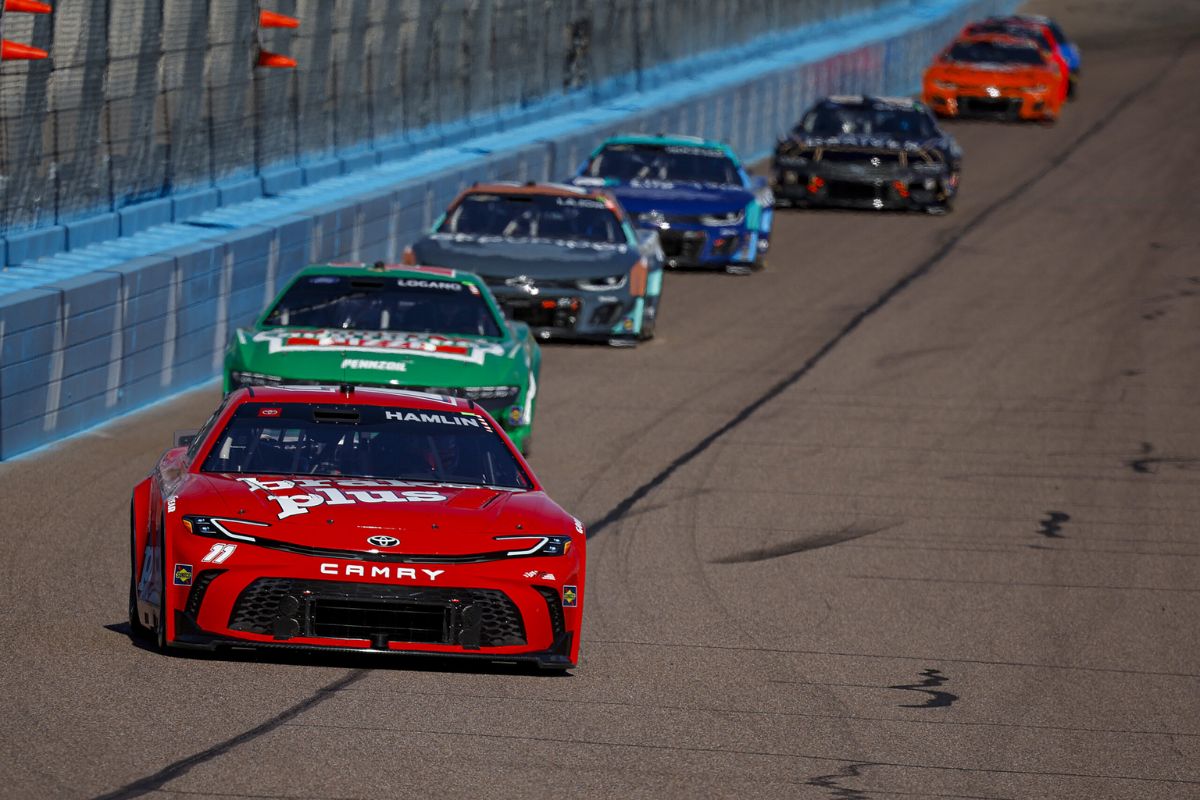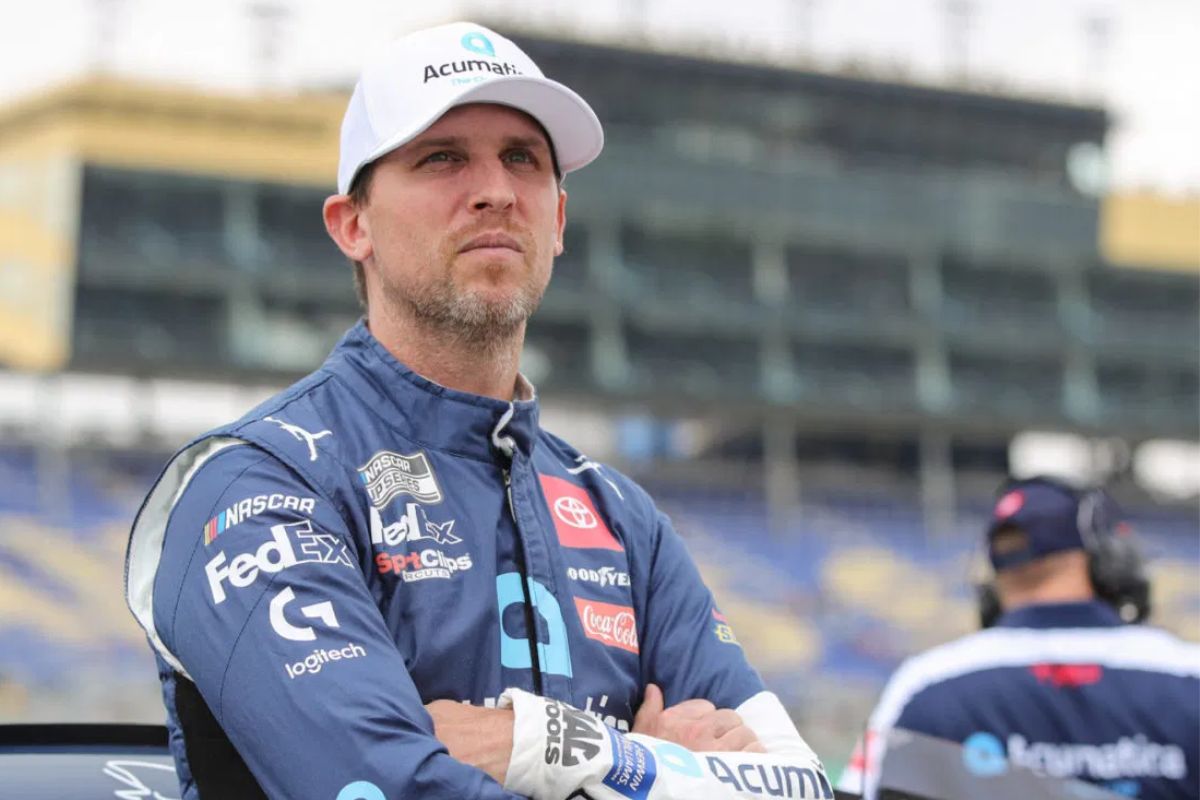Denny Hamlin Almost Gave Up Richmond Win: Denny Hamlin‘s near-miss at the Richmond race, where he hesitated to secure victory due to concerns over Austin Dillon‘s aggressive driving, raises intriguing questions about the psychological dynamics in motorsports. Hamlin’s reflections on the tension and chaos highlight the intense strain drivers face and underline the tactical importance of mental resilience in NASCAR. As the race unfolded, the decision-making process became a critical factor—what might this reveal about the interplay between instinct and tactics in racing?
Key Highlights
- Denny Hamlin felt anxiety due to Austin Dillon’s aggressive tactics, which influenced his strategy during the race.
- Dillon’s desperation to secure a playoff spot created unpredictability, making Hamlin cautious about his positioning.
- The chaotic environment led Hamlin to consider sacrificing a win to avoid potential collisions.
- Despite the tension, Hamlin managed to finish third, reflecting on the unpredictable nature of racing.
- Hamlin emphasized the importance of mental resilience and tactical decision-making amid high-pressure situations.
Chaos at the Cookout 400 Secures Austin Dillon’s Playoff Spot
The Cookout 400 erupted in chaos as Austin Dillon seized a essential opportunity to secure his playoff spot, turning the race into a battleground. In a shocking display of aggression, Dillon targeted race leader Joey Logano, colliding with his car and ultimately wrecking him. This decisive move was not merely a tactical strategy; it was a calculated risk taken in the heat of the moment to guarantee his advancement in the championship race.
Dillon’s reckless decision did not stop with Logano. He further compounded the chaos by crashing into Denny Hamlin’s vehicle, solidifying his reputation as a driver willing to do whatever it takes to achieve victory.
While Richard Childress Racing (RCR) may not have envisioned such a tumultuous path to the playoffs, they are certainly grateful for the outcome. With one car now in competition, RCR finds itself back in the championship conversation, albeit facing an uphill battle.
However, it is essential to note that Dillon stands notably behind other playoff contenders regarding points. This reality will quickly become apparent as the playoff races unfold.
Celebrations aside, the true test lies ahead for Dillon and RCR, who must now navigate the complexities of playoff racing with a limited margin for error.
Denny Hamlin Breaks Down the Richmond Chaos
Amid the aftermath of Austin Dillon’s aggressive tactics at the Cookout 400, Denny Hamlin offered his perspective on the chaos that unfolded during the race.
As the laps wound down, the tension was palpable; many anticipated a potential new winner, given Dillon’s assertive driving. Despite some questionable restarts, Dillon managed to position himself as a threat, ultimately confronting leader Joey Logano with an aggressive tactic that changed the dynamics of the race.
Hamlin, who was vying for a podium finish, reflected on the situation during a recent podcast. He recalled his thoughts upon exiting pit road in third position, rather than in the runner-up spot.
“I thought, ‘Oh man, maybe I get to the lead again like I did in the spring,’” he noted, revealing an underlying hope that his prior success could be replicated.
“I’ll be honest with you. I thought when I came off pit road third instead of second… because I came in second, and at that point, I’m thinking, ‘Oh man, maybe I get to the lead again like I did in the spring,’ right?” – hamlin
However, the race took an unexpected turn as Dillon’s intentions became clear. Analysts observed that Dillon’s aggressive approach appeared calculated, aimed at forcing Logano out of the way.
This moment of reckoning highlighted the unpredictable nature of racing, where desperation often leads to bold, and sometimes reckless, decisions.
As the race concluded, it was evident that the chaos not only secured Dillon’s playoff spot but also left Hamlin contemplating the fine line between aggression and caution in pursuit of victory.
Denny Hamlin’s Reaction to the Incident
Reflecting on the chaotic turn of events during the Cookout 400, Denny Hamlin expressed a mix of disappointment and understanding regarding his encounter with Austin Dillon. While the contact with Dillon ultimately put Hamlin into the wall, he managed to secure a tertiary finish, which he viewed with a sense of acceptance given the circumstances.
Hamlin articulated his rationale, stating, “When I came off third, I was not that disappointed because I felt as though I knew Austin was going to be very desperate.”
In a race where the outcome often hinges on the quality of restarts, Hamlin opted to approach the situation with caution. He shared insights into his thought process, revealing a keen awareness of the potential risks involved.
“If I got a good restart, I thought he was just going to wash up into me because… forgive me if I have PTSD about not finishing where I should be finishing week in and week out,” he admitted. This reflection emphasizes how past experiences can shape a driver’s instincts and decisions on the track.
Thoughts Running Through Denny Hamlin’s Mind
Steering through the high-pressure environment of a NASCAR race, Denny Hamlin found himself grappling with a whirlwind of thoughts as the chaos unfolded around him. The looming threat of Austin Dillon’s desperation added to the intensity of the moment. As Dillon raced aggressively, Hamlin’s mind was filled with apprehensions that questioned his own safety and race outcome.
“How am I going to get wiped out here and not finish where I deserve to finish on this day?”
“I’m going to get wiped out. This is just going to be bad.” – Hamlin
These mental distractions can cloud judgment, ultimately affecting race performance. Hamlin’s acknowledgment of Dillon’s desperation, particularly in the final corner, reflects a deeper understanding of the psychological battles that accompany physical racing. In this moment, while he wrestled with the fear of being taken out of the race, he also had to maintain control over his vehicle at breakneck speeds, a dual challenge that tested his mental fortitude and racing insight.
“I knew that the three were going to be desperate. I didn’t know how desperate until the final corner.” – hamlin
Denny Hamlin’s Post-Race Reflection
Denny Hamlin’s post-race reflection revealed a mix of relief and satisfaction following his strong performance at Richmond. Finishing in third place, he acknowledged the unpredictability of the final moments of the race, stating, “I was very aware but certainly didn’t think it would go like it did for the final 200 yards.” His ability to maintain composure amidst the chaos illustrated his experience and tactical mindset.
In reflecting on the race, Hamlin highlighted several key takeaways:
- Competitive Spirit: The intensity of racing demands constant vigilance, especially with desperate competitors like Austin Dillon in the field.
- Tactical Decisions: Understanding when to push and when to hold back is essential in maintaining a competitive edge.
- Mental Resilience: The mental aspects of racing can influence performance, requiring drivers to manage both fear and focus effectively.
- Future Outlook: With playoffs approaching, securing a solid finish is significant for momentum and confidence.
Hamlin’s insights not only reveal his appreciation for the subtleties of racing but also emphasize the importance of tactical thinking under stress.
The race may have concluded, but the discussions it sparks about strategy and competition continue to engage the community.
News in Brief: Denny Hamlin Almost Gave Up Richmond Win
The chaotic atmosphere during the Richmond race exemplified the intricate interplay between aggressive driving and mental resilience in competitive motorsports. Denny Hamlin’s experience highlights the important impact that external factors, such as another driver’s tactics, can have on decision-making and race outcomes. Ultimately, the ability to maintain composure amidst uncertainty proved vital, leading to a commendable third-position finish. This incident serves as a reminder of the complexities inherent in high-stakes racing environments and the necessity for tactical adaptability.
ALSO READ: NASCAR Faces Pressure From Denny Hamlin to Address Austin Dillon’s Wreck



